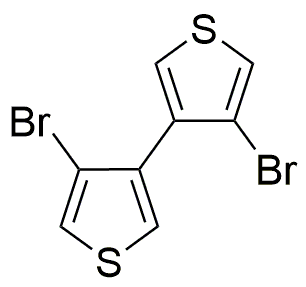4,4'-Dibromo-3,3'-bithiophene is widely utilized in research focused on:
- Organic Electronics: This compound is a key material in the development of organic semiconductors, particularly in organic photovoltaic cells and organic light-emitting diodes (OLEDs). Its unique electronic properties enhance device efficiency.
- Conductive Polymers: It serves as a building block for synthesizing conductive polymers, which are essential in various applications such as flexible electronics and sensors, offering advantages over traditional materials due to their lightweight and flexibility.
- Material Science: The compound is used in the creation of advanced materials with tailored properties, such as improved thermal stability and conductivity, making it valuable in the development of high-performance coatings and composites.
- Research in Photonics: Its properties are leveraged in photonic applications, including waveguides and lasers, where its ability to manipulate light can lead to innovations in communication technologies.
- Environmental Sensors: The compound is explored for use in sensors that detect environmental pollutants, providing a means for real-time monitoring and contributing to sustainability efforts.
Información general
Propiedades
Seguridad y normativas
Aplicaciones
4,4'-Dibromo-3,3'-bithiophene is widely utilized in research focused on:
- Organic Electronics: This compound is a key material in the development of organic semiconductors, particularly in organic photovoltaic cells and organic light-emitting diodes (OLEDs). Its unique electronic properties enhance device efficiency.
- Conductive Polymers: It serves as a building block for synthesizing conductive polymers, which are essential in various applications such as flexible electronics and sensors, offering advantages over traditional materials due to their lightweight and flexibility.
- Material Science: The compound is used in the creation of advanced materials with tailored properties, such as improved thermal stability and conductivity, making it valuable in the development of high-performance coatings and composites.
- Research in Photonics: Its properties are leveraged in photonic applications, including waveguides and lasers, where its ability to manipulate light can lead to innovations in communication technologies.
- Environmental Sensors: The compound is explored for use in sensors that detect environmental pollutants, providing a means for real-time monitoring and contributing to sustainability efforts.
Documentos
Hojas de datos de seguridad (HDS)
La SDS proporciona información de seguridad completa sobre la manipulación, el almacenamiento y la eliminación del producto.
Especificación del producto (PS)
La PS proporciona un desglose completo de las propiedades del producto, incluida la composición química, el estado físico, la pureza y los requisitos de almacenamiento. También detalla los rangos de calidad aceptables y las aplicaciones previstas del producto.
Certificados de análisis (COA)
Busque certificados de análisis (COA) ingresando el número de lote del producto. Los números de lote y de partida se pueden encontrar en la etiqueta de un producto después de las palabras "Lote" o "Lote".
Número de catálogo
Número de lote/lote
Certificados de origen (COO)
Este certificado de origen confirma el país en el que se fabricó el producto y también detalla los materiales y componentes utilizados en él y si se deriva de fuentes naturales, sintéticas u otras fuentes específicas. Este certificado puede ser necesario para cumplir con las normativas aduaneras, comerciales y regulatorias.
Número de catálogo
Número de lote/lote
Hojas de datos de seguridad (HDS)
La SDS proporciona información de seguridad completa sobre la manipulación, el almacenamiento y la eliminación del producto.
DownloadEspecificación del producto (PS)
La PS proporciona un desglose completo de las propiedades del producto, incluida la composición química, el estado físico, la pureza y los requisitos de almacenamiento. También detalla los rangos de calidad aceptables y las aplicaciones previstas del producto.
DownloadCertificados de análisis (COA)
Busque certificados de análisis (COA) ingresando el número de lote del producto. Los números de lote y de partida se pueden encontrar en la etiqueta de un producto después de las palabras "Lote" o "Lote".
Número de catálogo
Número de lote/lote
Certificados de origen (COO)
Este certificado de origen confirma el país en el que se fabricó el producto y también detalla los materiales y componentes utilizados en él y si se deriva de fuentes naturales, sintéticas u otras fuentes específicas. Este certificado puede ser necesario para cumplir con las normativas aduaneras, comerciales y regulatorias.


